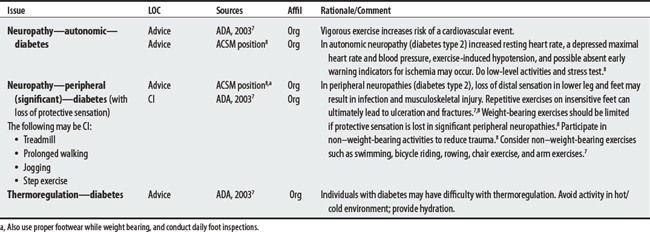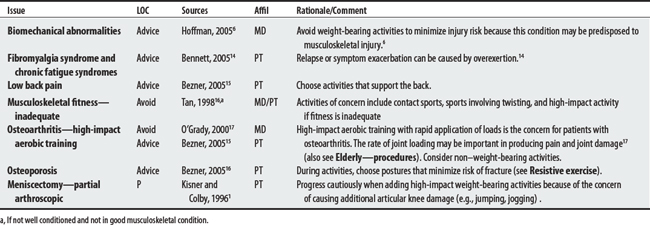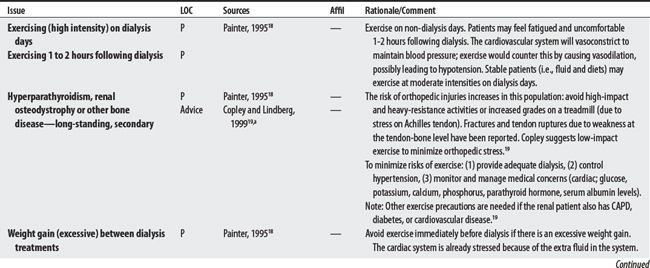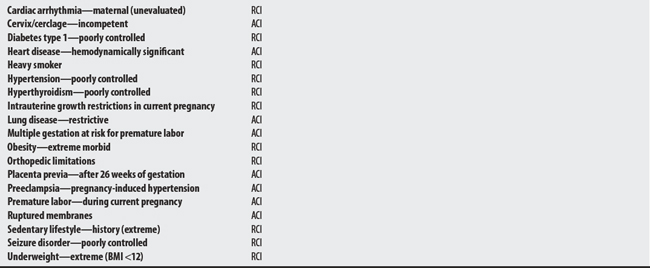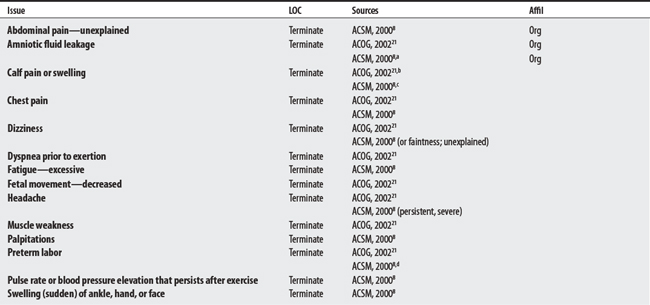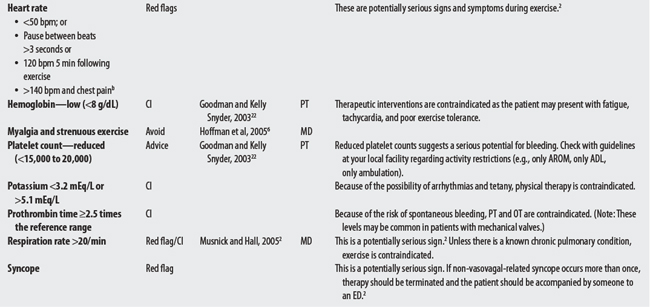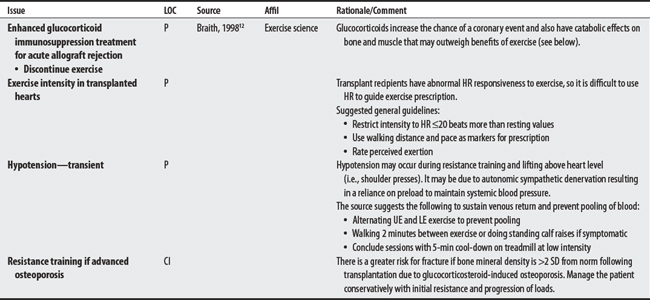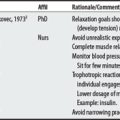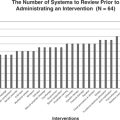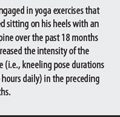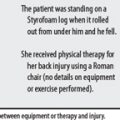Chapter 11 Aerobic
OVERVIEW.
Aerobic exercise involves submaximal, rhythmic, repetitive activity that uses large muscle groups and requires increasing uptake of oxygen.1 The goal for aerobic exercise is improved fitness (cardiovascular function), endurance (prolonged work without fatigue), maximal oxygen uptake (improved efficiency), conditioning (increased energy capacity), adaptation (ability to satisfy energy requirements at increasing activity levels), and the avoidance of deconditioning.
SUMMARY: CONTRAINDICATIONS AND PRECAUTIONS.
Notes: (1) “Red flags” noted by one source2 are conditions that may present with serious symptoms and signs during exercise—not just aerobic exercise. These conditions and associated signs suggest timely medical referral and/or management. (2) Aerobic exercise is a broad topic with diverse source backgrounds; some concerns may overlap with resistive exercise (also see Resistive exercise).
CONTRAINDICATIONS AND PRECAUTIONS
E00-E90 ENDOCRINE, NUTRITIONAL AND METABOLIC DISEASES
G00-G99 DISEASES OF THE NERVOUS SYSTEM
I00-I99 DISEASES OF THE CIRCULATORY SYSTEM
J00-J99 DISEASES OF THE RESPIRATORY SYSTEM
M00-M99 DISEASES OF THE MUSCULOSKELETAL SYSTEM AND CONNECTIVE TISSUE
N00-N99 DISEASES OF THE GENITOURINARY SYSTEM: DIALYSIS PATIENTS
1 Cameron MH. Physical agents in rehabilitation: From research to practice. St. Louis: W.B. Saunders, 2003.
2 Musnick D, Hall C. Red flags: Potentially serious symptoms and signs in exercising patients. Appendix 2. In: Hall CM, Brody LT, editors. Therapeutic exercise: Moving toward function. Philadelphia: Lippincott Williams & Wilkins, 2005.
3 Goodman CC, Snyder TEK. The endocrine and metabolic systems. In: Goodman CC, Boissonnault WG, Fuller KS, editors. Pathology: Implications for the physical therapist. Philadelphia: W.B. Saunders, 2003.
4 Neid RJ, Franklin B. Promoting and prescribing exercise for the elderly. Am Fam Phys. 2002;65(3):419-426.
5 Goodman CC, Snyder TEK. Problems affecting multiple systems. In: Goodman CC, Boissonnault WG, Fuller KS, editors. Pathology: Implications for the physical therapist. Philadelphia: W.B. Saunders, 2003.
6 Hoffman MD, Sheldahl LM, Kraemer WJ. Therapeutic exercise. DeLisa JA, editor. Rehabilitation medicine and rehabilitation: Principles and practice, ed 4, vol 1. Philadelphia: Lippincott Williams & Wilkins, 2005.
7 American Diabetes Association. Physical activity/exercise and diabetes. Diabetes Care. 2003;26:S73-S77.
8 Albright A, Franz M, Hornsby G, et al. ACSM position stand: Exercise and type 2 diabetes. Med Sci Sports Exerc. 2000;32(7):1345-1360.
9 Goodman CC. The cardiovascular system. In: Goodman CC, Boissonnault WG, Fuller KS, editors. Pathology: Implications for the physical therapist. Philadelphia: W.B. Saunders, 2003.
10 American College of Sports Medicine. ACSM’s guidelines for exercise testing and prescription, ed 6. Philadelphia: Lippincott Williams & Wilkins, 2000.
11 Goodman CC. The respiratory system. In: Goodman CC, Boissonnault WG, Fuller KS, editors. Pathology: Implications for the physical therapist. Philadelphia: W.B. Saunders, 2003.
12 Pagana KD, Pagana TJ. Mosby’s manual of diagnostic and laboratory tests, ed 2. St. Louis: Mosby, 2002.
13 Professional guide to diseases. ed 6. Springhouse (PA): Springhouse; 1998.
14 Bennett K. Therapeutic exercise for fibromyalgia syndrome and chronic fatigue syndrome. In: Hall CM, Brody LT, editors. Therapeutic exercise: Moving toward function. Philadelphia: Lippincott Williams & Wilkins, 2005.
15 Bezner JR. Impaired aerobic capacity/endurance. In: Hall CM, Brody LT, editors. Therapeutic exercise: Moving toward function. Philadelphia: Lippincott Williams & Wilkins, 2005.
16 Tan JC. Practical manual of physical medicine and rehabilitation: Diagnostics, therapeutics, and basic problems. St. Louis: Mosby, 1998.
17 O’Grady M. Therapeutic and physical fitness exercise prescription. Rheum Dis Clin North Am. 2000;26:617-646.
18 Painter P, Blagg CR, Moore GE. Exercise for the dialysis patient. Madison (WI): The Life Options Rehabilitation Advisory Council Medical Education Institute, 1995.
19 Copley JB, Lindberg JS. The risks of exercise. Adv Renal Replac Ther. 1999;6(2):165-171.
20 Pierson FM, Fairchild SL. Principles and techniques of patient care, ed 3. Philadelphia: W.B. Saunders, 2002.
21 ACOG Committee Obstetric Practice. ACOG Committee opinion. Number 267, January 2002: Exercise during pregnancy and the postpartum period. Obstet Gynecol. 2002;99(1):171-173.
22 Goodman CC, Kelly Snyder TE. Laboratory tests and values. In: Goodman CC, Boissonnault WG, Fuller KS, editors. Pathology: Implications for the physical therapist. Philadelphia: W.B. Saunders, 2003.
23 Consumer Product Safety Commission. Baby boomer sports injuries. April 2000. Available at: http://www.cpsc.gov/library/boomer.pdf. Accessed: October 26, 2005
11.2 Aquatic Therapy
OVERVIEW.
Aquatic therapy is a comprehensive approach to exercise in water that is designed to increase strength, flexibility, endurance, circulation, and relaxation1 (also see Hydrotherapy).
CONTRAINDICATIONS AND PRECAUTIONS
A00-B99 CERTAIN INFECTIONS AND PARASITIC DISEASES
F00-F99 MENTAL AND BEHAVIORAL DISORDERS
G00-G99 DISEASES OF THE NERVOUS SYSTEM
I00-I99 DISEASES OF THE CIRCULATORY SYSTEM
J00-J99 DISEASES OF THE RESPIRATORY SYSTEM
K00-K93 DISEASES OF THE DIGESTIVE SYSTEM
L00-L99 DISEASES OF THE SKIN AND SUBCUTANEOUS TISSUE
N00-N99 DISEASES OF THE GENITOURINARY SYSTEM
R00-R99 SYMPTOMS, SIGNS, AND ABNORMAL CLINICAL AND LABORATORY FINDINGS (NOT ELSEWHERE CLASSIFIED)
S00-T98 INJURY, POISONING, AND CERTAIN OTHER CONSEQUENCES OF EXTERNAL CAUSES
1 Bates A, Hanson N. Aquatic exercise therapy. Philadelphia: W.B. Saunders, 1996.
2 Wykle MO. Safety first. Rehab Manag. 2003;16(6):29. 27, 50
3 Giesecke CL. Aquatic rehabilitation of clients with spinal cord injury. In: Ruoti RG, Morris DM, Coles AJ, editors. Aquatic rehabilitation. Philadelphia: Lippincott-Raven, 1997.
4 McNeal R. Aquatic rehabilitation of clients with rheumatic disease. In: Ruoti RG, orris DM, Coles AJ, editors. Aquatic rehabilitation. Philadelphia: Lippincott-Raven, 1997.
5 Petersen TM. Pediatric aquatic therapy. In Cole AJ, Becker BE, editors: Comprehensive aquatic therapy, ed 2, Philadelphia: Butterworth-Heinemann, 2004.
6 Haralson KM. Therapeutic pool programs. Clin Manag Phys Ther. 1985;5(2):10-13.
7 Appendix B, guidelines for activity and exercise. In: Goodman CC, Boissonnault WG, Fuller KS, editors. Pathology: Implications for the physical therapist. Philadelphia: W.B. Saunders, 2003.
8 Congdon K. Aquatic rehabilitation of the client with cardiovascular disease. In: Ruoti RG, Morris DM, Coles AJ, editors. Aquatic rehabilitation. Philadelphia: Lippincott-Raven, 1997.
11.3 Cardiac Rehabilitation
OVERVIEW.
Cardiac rehabilitation is a supervised, interdisciplinary, goal-specific program used to restore persons with cardiac disease to achieve their optimal functional state (i.e., medical, physical, psychological, emotional, vocational). The program consists of four successive phases and incorporates education and lifestyle changes in addition to exercise.1,2 Together, the ACSM and AACVPR have listed 16 conditions of concerns for cardiac rehabilitation, 75% of which are circulatory related.
E00-E90 ENDOCRINE, NUTRITIONAL, AND METABOLIC DISEASES
I00-I99 DISEASES OF THE CIRCULATORY SYSTEM
M00-M99 DISEASES OF THE MUSCULOSKELETAL SYSTEM AND CONNECTIVE TISSUE
1 Eisenberg MG. Dictionary of rehabilitation. New York: Springer, 1995.
2 Tan JC. Practical manual of physical medicine and rehabilitation: Diagnostics, therapeutics, and basic problems. St. Louis: Mosby, 1998.
3 American College of Sports Medicine. ACSM’s guidelines for exercise testing and prescription, ed 6. Philadelphia: Lippincott Williams & Wilkins, 2000.
4 American Association of Cardiovascular and Pulmonary Rehabilitation. American Association of Cardiovascular and Pulmonary Rehabilitation guidelines for cardiac rehabilitation and secondary prevention programs, ed 4. Champaign (IL): Human Kinetics, 2004.
5 Goodman CC, Snyder TEK. The endocrine and metabolic systems. In: Goodman CC, Boissonnault WG, Fuller KS, editors. Pathology: Implications for the physical therapist. Philadelphia: W.B. Saunders, 2003.
6 Goodman CC, Snyder TEK. Problems affecting multiple systems. In: Goodman CC, Boissonnault WG, Fuller KS, editors. Pathology: Implications for the physical therapist. Philadelphia: W.B. Saunders, 2003.
7 Pagana KD, Pagana TJ. Mosby’s manual of diagnostic and laboratory tests, ed 2. St. Louis: Mosby, 2002.
8 Springhouse. Professional guide to diseases, ed 6. Springhouse (PA): Springhouse, 1998.
9 Goodman CC. The cardiovascular system. In: Goodman CC, Boissonnault WG, Fuller KS, editors. Pathology: Implications for the physical therapist. Philadelphia: W.B. Saunders, 2003.
10 Goodman CC. The respiratory system. In: Goodman CC, Boissonnault WG, Fuller KS, editors. Pathology: Implications for the physical therapist. Philadelphia: W.B. Saunders, 2003.
11 Appendix B, Guidelines for activity and exercise. In: Goodman CC, Boissonnault WG, Fuller KS, editors. Pathology: Implications for the physical therapist. Philadelphia: W.B. Saunders, 2003.
12 Braith RW. Exercise training in patients with CHF and heart transplant recipients. Med Sci Sports Exerc. 1998;30(10 Supp):S367-S372.



